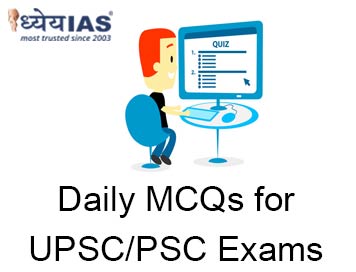Home > Daily-mcqs
Daily-mcqs 15 Jul 2025

Q1:
Consider the following statements regarding the Caracal: 1. It is a nocturnal and carnivorous animal. 2. It prefers dense tropical rainforests as its primary habitat. 3. It is categorized as an endangered species in India. 4. It is locally known as "Syahghosh" in some parts of the country. Which of the statements given above are correct?
A: 1, 2 and 3
B: 1, 3 and 4
C: 2 and 3 only
D: 1 and 4 only
Answer: B
Explanation:
· Caracals are shy, fast-running, nocturnal carnivores, typically active at night. Thus statement 1 is correct.
· They prefer dry, open, and bushy habitats, not dense tropical rainforests.
· In India, their population is extremely limited, and they are categorized as endangered. Thus statement 2 is incorrect and 3 is correct.
· The local name "Syahghosh" (meaning “black ear” or “black-voiced”) is used in regions like Rajasthan and Madhya Pradesh. Thus statement 4 is correct.
Q2:
1. It is the largest rhino species in the world. 2. It is currently classified as Endangered on the IUCN Red List. 3. It is protected under Schedule I of the Wildlife Protection Act, 1972. 4. It is found only in Assam and West Bengal in India. Which of the statements given above are correct?
With reference to the Indian one-horned rhinoceros, consider the following statements:
A: 1, 2 and 3 only
B: 1 and 3 only
C: 1, 3 and 4 only
D: 1, 2, 3 and 4
Answer: B
Explanation:
· Statement 1 is correct: The Indian one-horned rhino is the largest among the five extant rhino species.
· Statement 2 is incorrect: It is listed as Vulnerable, not Endangered, on the IUCN Red List.
· Statement 3 is correct: It enjoys Schedule I protection, the highest under Indian wildlife law.
· Statement 4 is incorrect: It is also found in Uttar Pradesh (e.g., Dudhwa Tiger Reserve).
Q3:
The Gyan Bharatam Mission, announced in the Union Budget 2025–26, primarily aims to:
A: Promote Sanskrit as a national language.
B: Preserve and digitize India's manuscript heritage using modern technologies.
C: Establish new libraries in rural India.
D: Translate Indian classical texts into all UN official languages.
Answer: B
Explanation:
The Gyan Bharatam Mission (GBM) builds on the earlier National Mission for Manuscripts (2003) and focuses on:
· Scientific preservation of ancient texts,
· Digitisation for broader access,
· Use of AI and Handwritten Text Recognition, and
· Training scholars and conservators.
Q4:
Under which Article of the Indian Constitution can the President nominate members to the Rajya Sabha?
A: Article 79
B: Article 80(1)(a)
C: Article 80(3)
D: Article 81(2)
Answer: C
Explanation:
Q5:
Consider the following statements: 1. Nominated members of the Rajya Sabha have the same powers as elected members of rajyasabha. 2. They can vote in the Presidential and vice president election. 3. They are allowed to join a political party within six months of their nomination. Which of the statements given above are correct?
A: 1 and 3 only
B: 1, 2 and 3
C: 2 and 3 only
D: 1 only
Answer: A
Explanation: